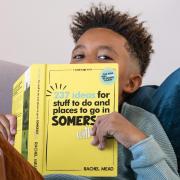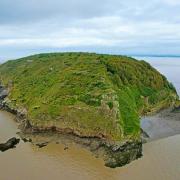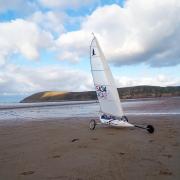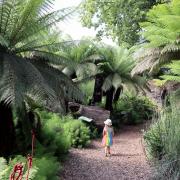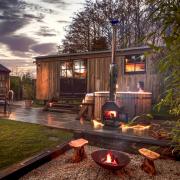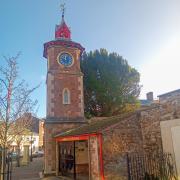According to the architectural historian, Nikolaus Pevsner, Nunney castle is ‘aesthetically the most impressive castle in Somerset.’ And when it comes to buildings, he’s the man. The castle is so cute and quaint you have an odd urge to pick it up, put it in your pocket and take it home.
The castle was built in the 1370s for Sir John De La Mare, a prominent local as the sheriff of Wiltshire and Somerset. He was granted a license to crenellate it by the king but the edifice was always more of a status symbol rather than a defensive structure due to the low-lying ground it was on. In the French style it had a quadrangular court with four tower columns. In the 16th century it was extensively modernised for the Prater family. They were in possession when it saw its only action, during the civil war, after a couple of days siege the Royalists limply surrendered. Parliament then decreed that the castle should not be used anymore, and it wasn’t. There was a structural collapse in 1910, so that what you see now is what the State took over in 1926 after the return of the moat.
Inside the castle there is just one small sign that says: ‘Please do not climb on the walls.’ Some years ago, on our first visit to Nunney, this is the sign we read just after my wife had fallen from the wall onto her bottom. The following morning produced the most purple derriere I have ever seen. Evidence, indeed, that one should heed warning signs.
Handy for monument visitors, The Café at Nunney is just up the road, run for the last 18 months by Ian Wyley and partner – for a Friday morning it was pretty full. Ian observed that compared to South Wales castles it was more of a fortified manor, but since it had bought a couple of cannonballs in it’s time, that was good enough for him. Ian said: ‘Nunney is a wonderful place, we’ve been made to feel very welcome by the residents, very well supported by the locals and those in the wider area as well. The village itself is a picture-box place, but one of the things that we like the most is that it has a deep-rooted community.’ It has been quoted that Nunney is the prettiest village in Somerset, this seems very subjective, particularly when I don’t know who said it. However, it does have a castle and moat (tick), it does have a 19th century guard house (tick), it does have a babbling brook (tick), it has excitable and energetic ducks in said brook (tick) and it has many attractive Georgian, and earlier, houses (tick). The old houses have ‘old’ in their names; The Old Bake House, The Old Coach House, The Old Brewery Cottage and other unusual names like The Hidden House and Thimble Cottage.
Less than a stone’s throw from the castle is the Grade I listed Church of All Saints dating back to the 12th century. The tombs and stone effigies of Sir John De La Mare and others can be found here. The vicar told me that when the Victorians decided to move the effigies, they had to cut the legs in order to squeeze them in – apparently English Heritage were appalled when they heard. Also in the church was an exhibition about the experience of Nunney during the second world war entitled ‘Keep Calm and Nunney On’. You learn about how Nunney Court on Donkey Lane was used as a hospital and a store for national treasures but more importantly you get a sense of how warfare impacted the lives of residents in a small Somerset village. You might instead get an exhibition on the church or the history of the village.
About a mile out of Nunney I came across an area known as Dead Woman’s Bottom – curiously it made me think of the castle and the wife.
Street Fayre
The highlight of the calendar year for the village is the annual fayre when the lanes come alive with a multitude of stalls and there is music at the castle.
This year the event, organized by the Nunney Community Association (NCA), will take place on Saturday July 27th.
The Nunney Street Fayre has been running for more than 50 years, but it missed out for three years because of COVID – it returned last summer and will take place again in 2024.
The NCA, which is completely independent of the Parish Council, is a mixed group of villagers. Quite a considerable amount of time and effort goes into putting on the fayre but the work is split between the team. An NCA organiser Tanya Barrett, who is also landlady at the George Inn, said: ‘The Fayre raises money for other events in the village like the Halloween party we do and the Father Christmas visit for the children later in the year. Then there are the little events like the Nunney duck race which we do at Easter time.’
Acoustic Café
Live music, food, drink, laughter and chatter comes to Nunney village hall on some Sunday afternoons.
The Acoustic Café used to be a monthly event but is now an irregular happening so contact Keren Heyden on 07968 753632 for further details.
The music varies from folk to rock to classical violin. Bands are arranged but there also bookable floor spots for everyone else.
POPULATION 856 (2021 census)
WHERE TO STAY: Right in the heart of the village, The George Inn can’t be missed because there is an old Wadworths pub sign that stretches right across Church Street. Plenty of the original interiors of the Grade II listed 18th century hotel have been kept. There’s a choice of gardens; a walled garden in the rear and a terrace that looks over the stream out the front. Inside there are 10 bedrooms, one of which is a suite with a four-poster bed. Four of the rooms have a view of the castle. georgeinnnunney@btinternet.com
















